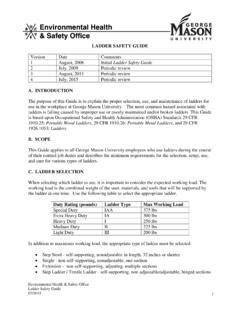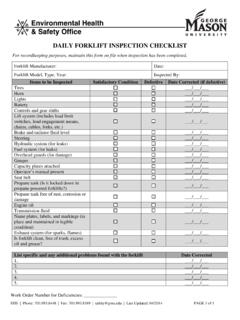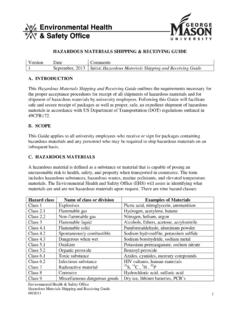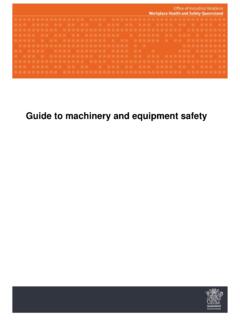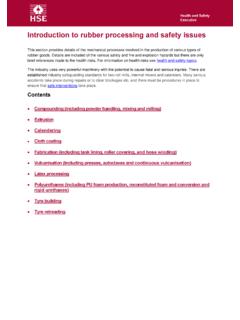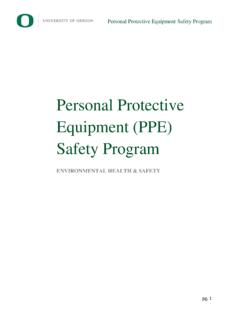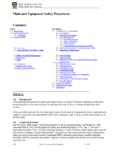Transcription of MACHINE AND MACHINE SHOP SAFETY GUIDE
1 Environmental Health & SAFETY Office MACHINE and MACHINE Shop SAFETY GUIDE 07/2015 1 MACHINE AND MACHINE SHOP SAFETY GUIDE Version Date Comments 1 October, 2008 Initial MACHINE and MACHINE Shop SAFETY GUIDE 2 August, 2011 Periodic review 3 July, 2015 Periodic review A. introduction The purpose of this GUIDE is to provide information to all George Mason University employees and students who work with machining tools and equipment in order to create a safe work environment. This GUIDE is based upon Occupational SAFETY and Health Administration (OSHA) Standard 29 CFR 1910 Subpart O: machinery and MACHINE Guarding. B. SCOPE This GUIDE applies to all George Mason University employees and students who operate machining tools and equipment . C. RESPONSIBILITES Operators are any employee or student who uses machining tools and equipment . Specific responsibilities of operators are: Comply with this GUIDE and any further SAFETY recommendations provided by supervisors, Environmental Health and SAFETY Office (EHS), and the manufacturer regarding MACHINE guarding, use, and SAFETY .
2 Conduct assigned tasks in a safe manner, wear appropriate personal protective equipment (PPE), and only use equipment for which you have received appropriate training. Complete MACHINE Shop SAFETY Checklist (Appendix A) when appropriate or required by your supervisor or EHS. Supervisors that oversee employees who operate machining tools and associated equipment are responsible for the following: Ensuring that each MACHINE operator receives proper training. Ensuring that all machines are properly guarded. Ensuring that inspections of all MACHINE tools and associated equipment are conducted. Environmental Health & SAFETY Office MACHINE and MACHINE Shop SAFETY GUIDE 07/2015 2 D. TRAINING All persons that operate machines and equipment must be trained by a qualified and experienced person. Training must be documented. Training records must include the specific MACHINE or equipment the individual is trained on, the date of training, and the signature of trainee and trainer.
3 Training must cover: General MACHINE SAFETY as outlined in Section E and F of this GUIDE . Individual MACHINE training to include: o Use of PPE, MACHINE maintenance, and MACHINE operation. o A description and identification of the hazard(s) associated with the MACHINE (s). o Guard positioning, how they provide protection, and the hazards for which they are intended to protect against. o What to do if a guard is damaged, missing, or unable to provide adequate protection. o Under what circumstances guards can be removed and by whom. Retraining must be provided if: There is a change in job assignment or activity that requires different machinery . There is a change in MACHINE (s) or equipment available for use. Additional job tasks or activities that present a new hazard. The supervisor, designated trainer, or EHS determines that retraining is necessary. E. GENERAL SAFETY The following general SAFETY guidance applies to all types of MACHINE equipment and must be observed whenever operating machinery .
4 Inspect machines and their accessories prior to use for missing parts, guards or shields, grips, or other damage such as frayed or damaged electrical cords or belts that may affect operation. If a defect is discovered, the MACHINE must be placed out of service until it is repaired or discarded. Out of service machines must be identified Out of Service, Do Not Use. SAFETY glasses or goggles must be worn at all times when operating machinery . Face protection must be worn when the face is exposed to flying particles. Wear work gloves capable of protecting against cuts and punctures from materials. Wear appropriate clothing that fits correctly and is free from loose material. Confine loose clothing, ties, long hair, or jewelry that can become caught in moving parts. Wear sturdy, closed-toe footwear. Establish good footing and maintain good balance while working. Wear a machinist s apron tied in a quick release manner. Clear unnecessary scrap, tools, and other objects from the work area before working.
5 Always keep hands a safe distance away from moving parts. Environmental Health & SAFETY Office MACHINE and MACHINE Shop SAFETY GUIDE 07/2015 3 Stop the MACHINE immediately if an odd noise, excessive vibration, or unusual MACHINE operation or performance occurs. Disconnect the MACHINE from the power sources prior to making repairs or service. Follow George Mason University s Lockout/Tagout Program if applicable. When finished working, shut off power; the MACHINE must come to a complete stop before leaving it unattended. Keep observers at a safe distance away from the work area. F. GENERAL REQUIREMENTS FOR ALL MACHINES The following general requirements for all machines should be followed in conjunction with the general SAFETY guidance outlined in Section E of this GUIDE : All machines must have proper guards capable of protecting persons from potential hazards and all guards must be in conformity with appropriate OSHA standards. If specific standards are not available, the MACHINE design and guards should prevent the operator from having any part of their body in the danger zone during the operation.
6 The following three areas on all machines (danger zones) must be guarded: o The point of operation: the area on a MACHINE where work is performed such as cutting, shaping, boring, or forming of stock. The guard here should also protect against flying chips and sparks. o Power transmission apparatus: all components of the mechanical system which transmits energy to the part of the MACHINE performing the work. These components include flywheels, pulleys, belts, connecting rods, couplings, cams, spindles, chains, cranks, and gears. o Other moving parts: all parts of the MACHINE which move while the MACHINE is working. These can include reciprocating, rotating, and transverse moving parts, ingoing nip and pinch points, as well as feed mechanisms and auxiliary parts of the MACHINE . Environmental Health & SAFETY Office MACHINE and MACHINE Shop SAFETY GUIDE 07/2015 4 Hand tools ( , feeders, push sticks) must be available if they increase the users SAFETY . equipment that requires containment such as revolving barrels, ovens, spray booths, lasers, or other physical hazards must be equipped with an enclosure interlocked with the drive mechanism or energy source.
7 When the periphery of the blades of a fan is less than seven feet above the floor or working level, the blades must be guarded. The opening of the guard must be no larger than one-half inch. A MACHINE designed for a fixed location must be securely anchored. Barricades or enclosures must be in place around automated machinery that poses a risk to the operator s SAFETY . G. ABRASIVE WHEEL machinery The following SAFETY procedures should be used in conjunction with the general SAFETY tips outlined in Section E of this GUIDE : Eye protection must be worn at all times. Guards must cover the spindle end, nut, and flange projections of the wheel. When mounting a wheel, the flanges (the collars, discs, or plates between which wheels are mounted) cannot be less than one-third (1/3) the diameter of the wheel. Abrasive wheel machinery must be equipped with secure, rigid, and adjustable work rests. The work rest must be securely clamped and adjustments cannot be made with the wheel in motion.
8 The work rest must be kept as close to the wheel as possible with a Environmental Health & SAFETY Office MACHINE and MACHINE Shop SAFETY GUIDE 07/2015 5 maximum opening of one-eighth (1/8) inch. Before using abrasive wheel machinery , the wheel must be closely inspected for damages and a ring test should be performed. o Tap the wheel gently with a light nonmetallic implement, such as the handle of a screwdriver for light wheels, or a wooden mallet for heavier wheels. If the wheel sounds cracked (dead), the wheel must be replaced. A sound and undamaged wheel will give off a clear metallic tone. o Wheels must be dry and free from sawdust when performing the ring test; otherwise, the sound will be deadened. o The wheels should be tapped at 45 on each side of the vertical centerline of the wheel. Then, the wheel should be rotated 45 and the test repeated again. The spindle speed of the MACHINE must be checked before mounting the wheel to be certain that it does not exceed the maximum operating speed marked on the wheel.
9 Before using the MACHINE , make sure that the adjustable tongue at the top of the wheel opening is located within one-fourth (1/4) inch of the wheel. All contact surfaces of wheel must be flat and free of foreign matter. The maximum exposure angles specified in the following table must not be exceeded. Guard Exposure Angles Type of Abrasive Wheel machinery Exposure Shall Begin at a Point: Maximum Exposure (Angles) Bench and Floor Stands No more than 65 above the horizontal plane of the wheel spindle 90 Bench and Floor Stands No more than 65 above the horizontal plane of the wheel spindle 125 (only when the nature of the work requires contact with the wheel below the horizontal plane of the spindle) Cylindrical Grinders No more than 65 above the horizontal plane of the wheel spindle 180 Surface Grinders and Cutting-Off Machines No less than 15 below the horizontal plane of the wheel spindle 150 Swing Frame Grinders Top half of the wheels shall be enclosed at all times 180 Automatic Snagging Machines Top half of the wheels shall be enclosed at all times 180 Top Grinding Where the work is applied to the wheel above the horizontal centerline 60 Stand to one side of the wheel when turning on the power.
10 Do not use the side of the grinding wheel to shape stock. Feed the stock into the wheel with light to medium pressure. Do not force the piece. Environmental Health & SAFETY Office MACHINE and MACHINE Shop SAFETY GUIDE 07/2015 6 H. GENERAL REQUIREMENTS FOR WOODWORKING machinery Each woodworking MACHINE must have a mechanical or electrical power control so that the operator can turn off the power without leaving the normal working position. For machines where injury to the operator might result if motors were to restart after power failures, provisions must be made to prevent machines from automatically restarting upon restoration of power. Power and operating controls must be within reach of the operator when occupying the normal working position. I. SAWS Saws are one of the more commonly used woodworking machines. The following SAFETY procedures should be used in conjunction with the general SAFETY tips outlined in Section E of this GUIDE . Radial saws must have the sides of the lower exposed portion of the blade guarded to the full diameter of the blade by a device that will automatically adjust itself to the thickness of the stock and remain in contact with stock being cut.
